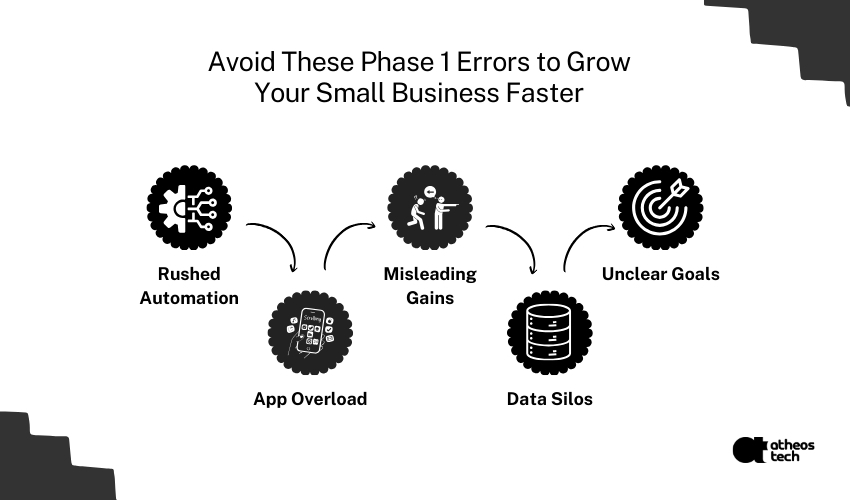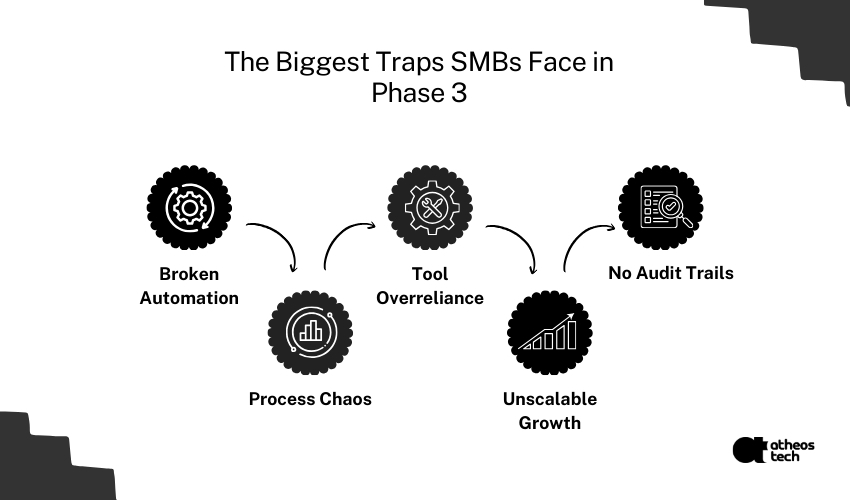
Hire UI UX Designer to Transform Your Brand Across Every Digital Channel

So, did you do it? The Introspection?
In our last guide on Digital Transformation for SMBs, we dropped a hard truth:
Most SMBs didn’t ‘transform’, they just signed up for a few SaaS tools and called it a day.
Digital transformation isn’t a status. It’s a process.
And most businesses are stuck somewhere between “sort of digital” and “we have no idea what’s working.”
If that stung a little, good. Your comfort is the #1 enemy in a market that’s moving faster than your internal operations. The right small business IT solutions aren’t about comfort; they’re about building a competitive edge.
The real question now is this:
Where exactly are you in your digital journey?
Because if you can’t pinpoint that, every app you buy, every small business consultant you hire, and every “automation” you implement is just expensive guesswork.
If you’re at a messy corner of your digital map, you’re ill. And we have the proven antidote. A proven 3-phase transformation model used by companies who didn’t just adopt tech – they built digital engines that scale like clockwork.
Phase 1: Management
Phase 2: Planning
Phase 3: Automation
This isn’t a list of more software to buy. This is your roadmap. It’s the GPS that will help you identify exactly where you are, why you feel stuck, and the very next, single most important step you need to take.
We’re going to walk through the three distinct phases of digital maturity: Management, Planning, and Automation. By the end, you won’t just understand the theory; you’ll have a clear, actionable framework to move your business from chaos to control.
Let’s get started.
Let’s be blunt. You can’t automate chaos. You can’t scale a mess. Before you can even think about advanced digital strategies, you have to wrestle the day-to-day operational chaos into submission.
This is Phase 1. Its goal isn’t about speed or revolutionary growth; it’s about clarity and control.
This is the foundational work most IT providers and DIY approaches skip entirely. Why? Because it’s not sexy. It’s not flashy. But it’s the only path that doesn’t collapse under its own chaos.
This isn’t the phase where you install AI, automate hiring, or build fancy dashboards. This is the garage clean-out phase.
You’re pulling everything onto the driveway, sorting through the mess, and finally figuring out what tools, files, and processes actually exist in your business.

Let’s ground this in reality. Here’s what Phase 1 looks like done right:
Think of it as setting up digital plumbing. If this part leaks, everything downstream floods.
You wouldn’t try automating a restaurant kitchen before organizing the pantry, right?
And yet, this is where most small business consulting firms mess up – they chase “efficiency” before building basic digital order.

Here’s what we see every week:
1.Automating without structure
“Let’s use Zapier to auto-send emails!”
Cool. But your contact list has 8 duplicates, 3 misspellings, and no tagging logic.
2.Tool overload without usage
“We use Notion, Trello, ClickUp, AND Excel.”
And you still have no idea where the final proposal lives.
3.Confusing ‘procurement’ with ‘progress’
“We bought licenses for everything.”
Great. But who set it up? Who trained the team? Who’s tracking usage? Crickets.
“Digital management is about control. Before you automate anything, you need to actually know what’s going on.”
And most SMBs don’t. They’re flying blind with 12 tools and zero visibility.
To create a single source of truth for every core area of your business:
This is the difference between a team that runs the business, and a team that’s run over by it.
The entire goal of Phase 1 can be summed up in five words: Create a Single Source of Truth. This phase isn’t optional. It’s survival.
Your roadmap to efficiency is here.
Manage smarter, Plan better, Automate faster.
You’ve survived Phase 1. The garage is clean. Your data is no longer scattered across a dozen spreadsheets and notebooks; it’s centralized in a few core systems. You have control.
Now, the real work begins. Welcome to Phase 2 – Planning. Where we stop winging it and start engineering how the business runs.
Phase 2 is where you stop just managing your business and start designing it. The goal here isn’t just clarity; it’s efficiency and intelligence.
Most businesses don’t “plan.” They improvise.
They buy a tool, use 30% of it, and hope things sort themselves out.
That’s not planning. That’s accidental digitalization.
This phase is where you step into system design mode – with purpose.
You start asking questions like:
You stop seeing departments as silos and start seeing cross-functional flow – where Sales, Ops, HR, Marketing, and Finance don’t just coexist… they collaborate.

Here’s what Planning looks like in practice:
This phase is where real small business IT solutions start pulling their weight – because now you’re using them with intention.
Blunt truth? Through our consulting services for small business, we’ve seen that most founders are too busy putting out fires to think like architects.. So they stay in “Tool Mode” and never reach “System Mode”. Many businesses jump directly from the chaos of Phase 1 to the allure of Phase 3 automation. This is a fatal error.

Let’s see some examples:
1.Thinking buying software = planning
“We got HubSpot, we’re good now.”
Cool. Who mapped the flow? Who owns the pipeline stages? Who built the KPIs?
Software is the hammer. You still need blueprints.
2.Firefighting founders
When your day is 90% “urgent,” you never design for what’s important.
Result: everything’s duct-taped together and held by good intentions.
3.Process-blind teams
Most teams are hired to do, not to design.
If you don’t train them to spot inefficiencies, they’ll just work around them forever.
“Planning is the least exciting and most critical phase.If you don’t know your current flow, automation just multiplies the mess.”
I’d rather have a brilliant process run on basic tools than a brilliant tool run on a chaotic process.
The real goal of Phase 2 isn’t just “better processes” – it’s operational predictability. You want to reach a point where:
Most consulting services for small business overlook this middle phase – and that’s why automation fails
You’ve built the foundation (Phase 1).
You’ve designed the system (Phase 2).
Now – let’s step off the hamster wheel.
Welcome to Phase 3: Automation – the phase where you stop babysitting your business and start letting it run itself. The goal here isn’t just efficiency; it’s exponential scale.
But don’t get it twisted.
Automation isn’t about replacing people. It’s about removing the dumb, repetitive stuff that should be handled by tech.

Let’s get tactical. This is the phase where:

Let’s get tactical. This is the phase where:
Here’s where 90% of small businesses burn their digital budgets because they skipped the prior phases. The power of this phase is matched only by the danger of its pitfalls.

1.Automating broken processes
Automating chaos doesn’t fix it. It just delivers bad results faster.
(Automated invoice errors, anyone?)
2.Relying too much on glue tools (e.g. Zapier)
“If Zap A breaks, then B fails, then C never triggers.”
That’s not automation. That’s Rube Goldberg meets Excel.
3.No audit trails, no rollback, no logic
When things go wrong (they will), can you trace what happened?
If not, your automation isn’t scalable. It’s fragile.
If your small business consulting company is pushing automation before organizing your ops, it’s time to reconsider.
“As a small business consultant, our view is quite simple: Automation is not a magic wand. It’s gasoline. If your engine’s broken, it just blows things up faster.”
Translation: If you haven’t clarified, cleaned, and codified your workflows – automating them will just multiply the mess. So, before getting into phase-3; you have to be 100% sure about satisfying phase 1 & 2.
Let’s get into what real small business IT solutions do in this phase
To create a frictionless, scalable operating model that doesn’t demand more bodies to grow revenue.
You’re not just digitized. You’re optimized.
You’re not just saving time. You’re multiplying capacity.
And the best part?
It all happens while your team can (literally) sleep.
Enough theory. Time for a brutally honest look in the mirror.
The biggest barrier to progress isn’t a lack of technology; it’s a lack of self-awareness. You can’t get where you’re going if you don’t know your true starting point.
Before hiring another small business consultant, let us run a diagnostic and map your exact digital phase.
Answer these 10 statements with a simple YES or NO:
1. Our client data is stored in a spreadsheet (or worse – multiple versions of it).
2. We still send invoices manually using Word or Excel.
3. There’s no central dashboard showing sales, operations, and finances in real time.
4. Asking “What’s the project status?” leads to a 30-minute team call.
5. We’ve purchased software we barely use.
6. Our lead nurturing is done manually, one email at a time.
7. We use WhatsApp groups or emails to manage tasks.
8. A client issue from last week is still unresolved because it “slipped through.”
9. Different departments use different systems that don’t talk to each other.
10. If I took a week off, things would fall apart.
Score 8–10 YES → You’re in Phase 1: Management
Your business is running on duct tape and goodwill. Time to get some digital scaffolding in place – yesterday.
Score 4–7 YES → You’re in Phase 2: Planning
You’ve got systems, but they’re not singing in harmony. You’re reacting, not scaling. Now’s the time to tighten up your flows.
Score 0–3 YES → You’re in Phase 3: Automation
Look at you, fancy operator. If your growth is plateauing, it’s time to scale smarter and audit your automation logic for resilience.
To simplify:
1. If you’re still sending Excel invoices… welcome to Phase 1
2. If your team needs meetings to “update each other”… hello Phase 2.
3. If your sales rep gets a Slack ping before they even know a lead came in… you’re flirting with Phase 3.
Let’s take your SMB through the winning cycle.
From Management to Automation
Stop fantasizing about automation if you’re still drowning in spreadsheets.
The #1 mistake small and mid-sized businesses make?
They jump to Phase 3 (Automation) before they’ve even survived Phase 1 or lived through phase 2.
Get control (Management)
Get efficient (Planning)
Get scalable (Automation)
The order is non-negotiable.
“But we’re using a CRM!”
Cool. Are you using it – or just paying for it?
“We’ve set up automation!”
Awesome. Is it solving real problems or just masking old ones with new UI?
Your problem isn’t a tool deficiency. SMBs today don’t need more apps, more software, or more digital noise. They need less chaos and more clarity. They need a structured transformation, not another subscription.
Your goal isn’t to be in Phase 3 tomorrow. Your goal is to master the phase you are in today. Get control. Then, get efficient. Only then have you earned the right to scale.
The next logical step is not to open a new tab and shop for software. It’s to get a second opinion on your diagnosis and build a real roadmap. Stop chasing disjointed small business IT solutions. Start building a system.
This is what we do.
As a dedicated small business consulting company, we don’t start by selling you software. We start by running a diagnostic to map your exact phase and identify the single biggest bottleneck that’s holding you back. We’re not just another small business consulting company throwing tools at your team. We build scalable engines that work.
We help you build the roadmap first, so every future technology decision is a strategic step, not a random guess. Unlike traditional small business consulting firms, AtheosTech doesn’t start with recommendations – we start with diagnosis.
Stop the cycle of buying apps to patch problems. It’s time to build a foundation that prevents them in the first place. Looking for expert consulting services for small business growth? Start with a strategic clarity session.
Book a complimentary 30-minute strategic clarity session now.
Adding {{itemName}} to cart
Added {{itemName}} to cart